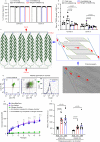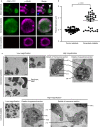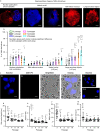Highly efficient platelet generation in lung vasculature reproduced by microfluidics
- PMID: 37419900
- PMCID: PMC10329040
- DOI: 10.1038/s41467-023-39598-9
Highly efficient platelet generation in lung vasculature reproduced by microfluidics
Abstract
Platelets, small hemostatic blood cells, are derived from megakaryocytes. Both bone marrow and lung are principal sites of thrombopoiesis although underlying mechanisms remain unclear. Outside the body, however, our ability to generate large number of functional platelets is poor. Here we show that perfusion of megakaryocytes ex vivo through the mouse lung vasculature generates substantial platelet numbers, up to 3000 per megakaryocyte. Despite their large size, megakaryocytes are able repeatedly to passage through the lung vasculature, leading to enucleation and subsequent platelet generation intravascularly. Using ex vivo lung and an in vitro microfluidic chamber we determine how oxygenation, ventilation, healthy pulmonary endothelium and the microvascular structure support thrombopoiesis. We also show a critical role for the actin regulator Tropomyosin 4 in the final steps of platelet formation in lung vasculature. This work reveals the mechanisms of thrombopoiesis in lung vasculature and informs approaches to large-scale generation of platelets.
© 2023. The Author(s).
Conflict of interest statement
P.W.G. and E.C.H. receive funding from TroBio Therapeutics, a company commercialising tropomyosin-targeting drugs. P.W.G. and E.C.H. are directors and shareholders of TroBio. All other authors declare no competing interests.
Figures









Similar articles
-
Detection of abundant megakaryocytes in pulmonary artery blood in lung cancer patients using a microfluidic platform.Lung Cancer. 2018 Nov;125:128-135. doi: 10.1016/j.lungcan.2018.09.011. Epub 2018 Sep 16. Lung Cancer. 2018. PMID: 30429010
-
Infusion of mature megakaryocytes into mice yields functional platelets.J Clin Invest. 2010 Nov;120(11):3917-22. doi: 10.1172/JCI43326. Epub 2010 Oct 25. J Clin Invest. 2010. PMID: 20972336 Free PMC article.
-
OP9 bone marrow stroma cells differentiate into megakaryocytes and platelets.PLoS One. 2013;8(3):e58123. doi: 10.1371/journal.pone.0058123. Epub 2013 Mar 1. PLoS One. 2013. PMID: 23469264 Free PMC article.
-
Recent lessons learned for ex-vivo platelet production.Curr Opin Hematol. 2021 Nov 1;28(6):424-430. doi: 10.1097/MOH.0000000000000662. Curr Opin Hematol. 2021. PMID: 34232141 Free PMC article. Review.
-
The platelet-vessel wall interaction in experimental atherosclerosis and ischaemic heart disease with special reference to thrombopoiesis.Dan Med Bull. 1992 Apr;39(2):110-27. Dan Med Bull. 1992. PMID: 1611918 Review.
Cited by
-
Mechanical confinement prevents ectopic platelet release.Proc Natl Acad Sci U S A. 2024 Sep 17;121(38):e2407829121. doi: 10.1073/pnas.2407829121. Epub 2024 Sep 5. Proc Natl Acad Sci U S A. 2024. PMID: 39236232 Free PMC article.
-
Platelet-Rich Plasma in Dermatology: New Insights on the Cellular Mechanism of Skin Repair and Regeneration.Life (Basel). 2023 Dec 25;14(1):40. doi: 10.3390/life14010040. Life (Basel). 2023. PMID: 38255655 Free PMC article. Review.
-
SARS-CoV-2 infection modifies the transcriptome of the megakaryocytes in the bone marrow.Blood Adv. 2024 Jun 11;8(11):2777-2789. doi: 10.1182/bloodadvances.2023012367. Blood Adv. 2024. PMID: 38522092 Free PMC article.
-
Packaging of supplemented urokinase into alpha granules of in vitro-grown megakaryocytes for targeted nascent clot lysis.Blood Adv. 2024 Jul 23;8(14):3798-3809. doi: 10.1182/bloodadvances.2024012835. Blood Adv. 2024. PMID: 38805575 Free PMC article.
-
Precision Cut Lung Slices: Emerging Tools for Preclinical and Translational Lung Research. An Official American Thoracic Society Workshop Report.Am J Respir Cell Mol Biol. 2024 Nov 5;72(1):16-31. doi: 10.1165/rcmb.2024-0479ST. Online ahead of print. Am J Respir Cell Mol Biol. 2024. PMID: 39499861 Free PMC article.
References
Publication types
MeSH terms
Grants and funding
LinkOut - more resources
Full Text Sources

